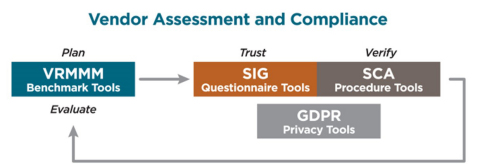TMCnet News
Shared Assessments Introduces 2019 Third Party Risk Management Toolkit UpdatesThe Shared Assessments Program, the member-driven leader in third party risk assurance, today issued the 2019 Shared Assessments Third Party Risk Management Toolkit. The components of the Toolkit allow organizations to manage the full vendor assessment relationship lifecycle - from planning a third party risk management program, to building and capturing assessments, to benchmarking and ongoing evaluation of a program. This press release features multimedia. View the full release here: https://www.businesswire.com/news/home/20190108005631/en/ 
The Toolkit embodies a "Trust, but Verify" approach for conducting third party risk management assessments built on evidence-based, standardized methodology. (Graphic: Business Wire) The Shared Assessments Third Party Risk Management Toolkit was built by the member community, leveraging the collective intelligence of diverse practitioners, and spanning industries and perspectives. "As is now reported on an almost daily basis, third party IT security risks can cause millions of dollars in loss and damage, and possibly irreparable harm to an organization's reputation. The continually escalating pace of attacks and the innovation that bad actors now employ means that organizations must be continuously vigilant," said Glen Sgambati, risk management expert and 2019 Shared Assessments Program Chair from member Early Warning Services. "Given the scope of the threat, no one organization can go it alone. The Shared Assessments 2019 Third Party Risk Management Toolkit is an asset that affords risk management professionals speed and flexibility in creating and conducting vendor assessments." "With the growing need of a risk-based approach to Third Party Risk Assessments, the 2019 Shared Assessments Risk Management Toolkit makes it so much easier to be able to demonstrate that concept, no matter what industry the user is in," said Angela Davis Dogan, Director of Vendor Risk & Compliance Services, Lynx Technology Partners. "From the starting point of its first availability, the Shared Assessments Standard Information Gathering (SIG) Questionnaire Tool and the Standardized Control Assessment (SCA) Procedure Tool have been a library of best practice questions and assessment processes. With the 2019 Toolkit, they are presented in a way that makes that fact even clearer to all users of the tools." Continuous quality improvement evaluation of the Toolkit is conducted to ensure that updates are reliable, relevant and efficient. Due to the pace and volume of vendor arrangements at most organizations, standardization is key to managing third party risk efficiently and effectively, but flexibility and customization are also often necessary. The Toolkit meets the need for both standardization and flexibility. The components of the 2019 Toolkit are:
New for 2019: Lighter Architecture, Custom Scoping, Assessment Streamlining In addition to updating all the Program Tools to account for new regulations and frameworks, as well as making updates for emerging technologies and threats, there were some major changes to how the Tools function. These changes were made in response to members who want speed and flexibility in creating, administering and storing their assessments. Major changes made include the 2019 SIG Questionnaire Tools now contain a vendor assessment questionnaire builder, rather than a static questionnaire. Other changes include:
Another new feature in 2019, is an accompanying Glossary intended to unify and inform the field of third party risk management and improve overall communications in the field. The Toolkit is constantly updated with the most relevant and current US and International regulatory and privacy content such as NIST 800-53r4, NIST CSF 1.1, FFIEC CAT Tool, the EU GDPR and PCI (News - Alert) 3.2.1. The Toolkit was designed to work together to help third party risk practitioners with all aspects of the third party risk management lifecycle. About the Shared Assessments Program As the only organization that has uniquely positioned and developed standardized resources to bring efficiencies to the market for more than a decade, the Shared Assessments Program has become the trusted source in third party risk assurance. Shared Assessments offers opportunities for members to address global risk management challenges through committees, awareness groups, interest groups and special projects. Join the dialog with peer companies and learn how you can optimize your compliance programs while building a better understanding of what it takes to create a more risk sensitive environment in your organization.
View source version on businesswire.com: https://www.businesswire.com/news/home/20190108005631/en/ |

